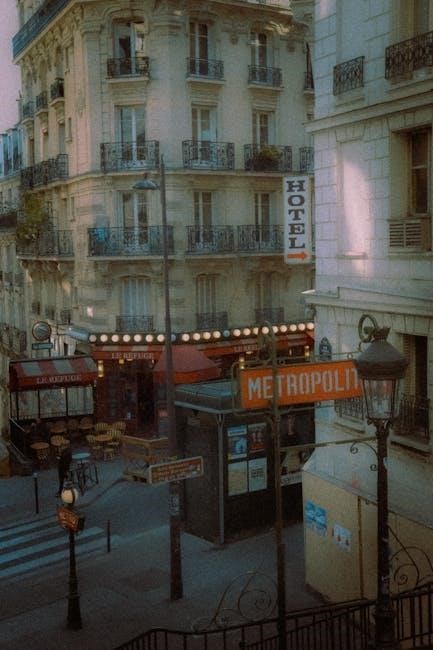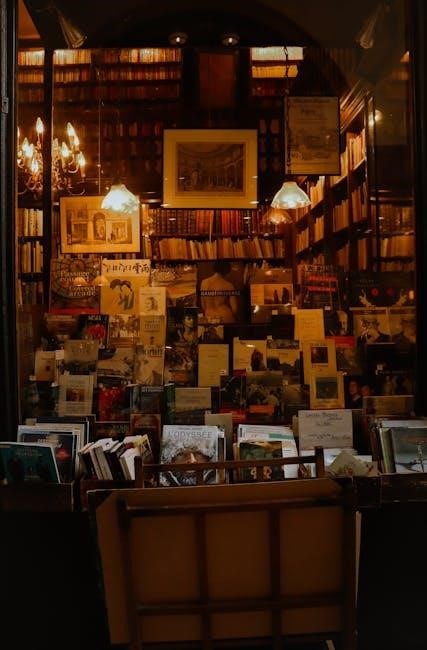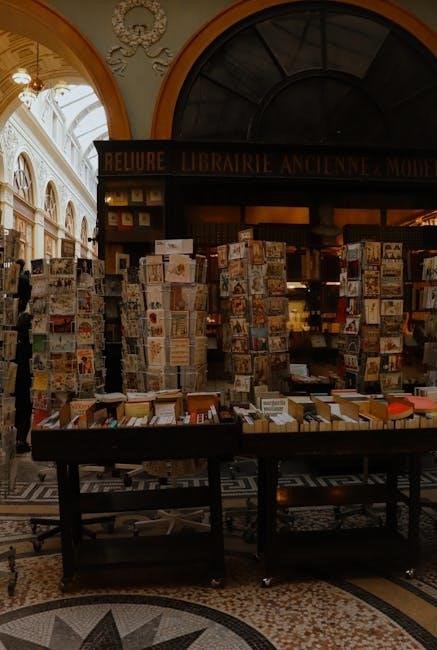
devil in the white city book pdf
The Devil in the White City: A Comprehensive Guide
Dive into Erik Larson’s enthralling non-fiction masterpiece, “The Devil in the White City,” exploring the juxtaposition of Daniel Burnham’s architectural vision for the 1893 Chicago World’s Fair and H.H. Holmes’s sinister activities during that era.
Overview of the Book
Erik Larson’s “The Devil in the White City” masterfully intertwines the grandeur of the 1893 Chicago World’s Fair with the chilling tale of H.H. Holmes, a serial killer operating in its shadow. The book delves into the parallel narratives of Daniel Burnham, the fair’s architect, striving to create a spectacle of innovation and wonder, and Holmes, who uses the fair to lure victims to his “Murder Castle.” This captivating non-fiction narrative explores themes of ambition, innovation, and the dark underbelly of progress, drawing readers into a mesmerizing era of magic and majesty contrasted with horrifying true crime.

Synopsis and Key Themes
“The Devil in the White City” explores ambition, innovation, and darkness against the backdrop of the 1893 Chicago World’s Fair. It interweaves architecture, true crime, and historical events seamlessly.
The Dual Narrative Structure
Erik Larson’s “The Devil in the White City” masterfully employs a dual narrative, contrasting the grandeur of the 1893 World’s Columbian Exposition with the chilling deeds of H.H. Holmes. This structure heightens the tension and underscores the duality of human nature. One narrative focuses on Daniel Burnham, the architect striving to create a dazzling spectacle, symbolizing progress and hope. The other follows Holmes, a cunning serial killer who exploits the fair’s allure to lure victims. By juxtaposing these stories, Larson creates a compelling exploration of light and darkness, innovation and depravity, making the book a gripping read.
Daniel Burnham and the World’s Fair
Daniel Burnham, a visionary architect, is central to “The Devil in the White City,” tasked with realizing the ambitious 1893 World’s Columbian Exposition in Chicago. His relentless pursuit to create a breathtaking spectacle showcases innovation. Burnham faces immense challenges, from tight deadlines to logistical nightmares, striving to make his mark on history. He embodies the spirit of progress and determination, racing against time and adversity to bring the fair to life. Burnham’s story highlights the transformative power of vision and perseverance. His architectural contributions symbolize the era’s optimism, contrasting sharply with the darkness lurking nearby.
H.H. Holmes and His Horrors
Dr. H.H. Holmes, a central figure in “The Devil in the White City,” embodies pure evil amidst the grandeur of the 1893 World’s Fair. He built a “murder castle” near the fairgrounds, designed with hidden passages and torture chambers. Holmes used the fair to lure unsuspecting victims, preying on their vulnerability. His actions contrasted sharply with the era’s optimism, showcasing a dark underbelly. Holmes’s story is a chilling exploration of human depravity and manipulation. He represents the madness lurking beneath the surface of progress. The book delves into his psychology, revealing the chilling nature of a calculating serial killer.

Historical Context
“The Devil in the White City” vividly portrays the late 19th century, focusing on Chicago’s transformation and the backdrop of the 1893 World’s Columbian Exposition. This era of innovation is essential to understanding the book.
The 1893 World’s Columbian Exposition
The 1893 World’s Columbian Exposition, also known as the Chicago World’s Fair, was a pivotal event. It showcased American innovation and grandeur, attracting millions worldwide. Daniel Burnham’s architectural leadership was crucial in creating this “White City,” a symbol of progress. Simultaneously, H.H. Holmes exploited the fair’s allure, committing heinous crimes amidst the celebration.
The fair featured prominent figures like Buffalo Bill and Thomas Edison. It became a stage for both dreams realized and nightmares unfolding, underscoring the era’s contrasting elements. The Exposition left an indelible mark on Chicago and American history, highlighting a period of transformative change.
Chicago in the Late 19th Century
Late 19th-century Chicago was a city undergoing rapid transformation and explosive growth. It rose from the ashes of the Great Fire to become a bustling metropolis. This era of expansion attracted both ambitious innovators and opportunistic criminals. The city’s infrastructure struggled to keep pace with its burgeoning population, creating social disparities.
The 1893 World’s Fair was intended to showcase Chicago’s resilience and modernity, but it also exposed deeper societal issues. Amidst the architectural marvels and technological advancements, crime and poverty persisted, providing a stark contrast to the fair’s utopian vision and Theodore Dreiser also was on the fair.

Characters and Key Figures
Explore the lives of Daniel Burnham, the visionary architect, and H.H. Holmes, the cunning serial killer, alongside other historical figures who shaped the landscape of the 1893 Chicago World’s Fair era.
Daniel Burnham: The Architect
Daniel Burnham, a demanding yet visionary architect, is portrayed as a pivotal figure in Erik Larson’s “The Devil in the White City.” He races against time to make his mark on history with the 1893 Chicago World’s Fair. Burnham’s character embodies ambition and determination as he faces immense pressure to complete the monumental project. His story is one of innovation, leadership, and the relentless pursuit of excellence amidst daunting challenges. The book delves into his struggles, triumphs, and the personal sacrifices he made to bring the White City to life, showcasing his architectural genius and unwavering commitment to his vision.
H.H. Holmes: The Serial Killer
Dr. H.H. Holmes, a central figure in “The Devil in the White City,” represents the dark underbelly of the glittering 1893 Chicago World’s Fair. In contrast to Burnham’s architectural marvel, Holmes constructs a “murder castle” designed for his sinister purposes. The book explores Holmes’s cunning and manipulative nature as he preys on unsuspecting victims. His story is a chilling account of deception, psychopathy, and the hidden horrors lurking beneath the surface of a seemingly utopian world. Larson delves into the psychology of Holmes, painting a portrait of a man born with the devil in him, driven by an insatiable urge to kill.
Other Notable Figures of the Era
“The Devil in the White City” is populated by a fascinating cast of real-life individuals who contributed to the vibrant tapestry of the 1893 World’s Columbian Exposition. Beyond Burnham and Holmes, the book features figures like Buffalo Bill, representing the allure of the Wild West. Visionaries such as Thomas Edison are mentioned, embodying the era’s technological advancements. Additionally, the narrative subtly incorporates historical figures such as Susan B. Anthony and Archduke Franz Ferdinand, weaving them into the broader context of the time. These individuals, whether directly involved in the fair or simply emblematic of the era, enrich the historical backdrop against which the main narratives unfold, highlighting the magic and majesty of the time.

Themes and Motifs
Larson’s narrative explores profound themes like good versus evil, contrasting Burnham’s architectural triumphs with Holmes’s dark deeds. The book also delves into magic and madness, and the transformative power of the fair itself.
Good vs. Evil
“The Devil in the White City” presents a stark contrast between the forces of good and evil. Daniel Burnham, the visionary architect, embodies the pursuit of progress, beauty, and innovation as he races against time to construct the magnificent World’s Columbian Exposition. His ambition and dedication represent the best of human endeavor, aiming to create a spectacle of wonder and enlightenment for the world.
Conversely, H.H. Holmes, the cunning serial killer, lurks in the shadows, exploiting the fair’s allure to prey on unsuspecting victims. His actions epitomize the darkest aspects of human nature, a chilling reminder of the evil that can exist alongside progress and prosperity. The juxtaposition of these two figures highlights the perpetual struggle between light and darkness, showcasing the capacity for both extraordinary creation and unspeakable destruction within humanity. The book vividly portrays this dichotomy, leaving the reader to contemplate the complex interplay between good and evil in society.
Magic and Madness
Erik Larson’s “The Devil in the White City” masterfully intertwines the themes of magic and madness, creating a captivating narrative that explores the extremes of human experience. The 1893 World’s Columbian Exposition, a spectacle of innovation and grandeur, evokes a sense of wonder and magic, captivating visitors with its architectural marvels, technological advancements, and cultural displays. This enchanting atmosphere, however, serves as a backdrop for the chilling madness of H.H. Holmes, whose calculated and depraved actions lurk beneath the fair’s shimmering facade.
Holmes’s character embodies the descent into madness, as he manipulates and murders unsuspecting individuals with cold precision. The juxtaposition of the fair’s magical allure and Holmes’s sinister madness heightens the tension and underscores the fragility of human sanity. Larson skillfully crafts a narrative that oscillates between awe and horror, leaving readers to ponder the fine line between the extraordinary and the deranged. The book’s exploration of these themes adds depth and complexity to the historical account, making it a truly unforgettable read.
The Transformative Power of the Fair
The 1893 World’s Columbian Exposition in “The Devil in the White City” serves as a powerful catalyst for change, leaving an indelible mark on both individuals and the nation. Daniel Burnham’s architectural vision transforms Chicago into a dazzling metropolis, showcasing American ingenuity and progress. The fair inspires awe and wonder, broadening horizons and sparking new ideas among its visitors. It introduces groundbreaking innovations, shaping future technologies and cultural trends.
However, the fair’s transformative power extends beyond mere progress. For some, like H.H. Holmes, it provides opportunities for manipulation and evil. The anonymity and excitement of the event allow him to prey on vulnerable individuals, highlighting the dark side of progress. Thus, the fair’s transformative power reveals both the best and worst of human nature, forever altering the landscape of American society and the lives intertwined with it. The book vividly captures this duality.

Literary Analysis
Erik Larson masterfully blends historical fact with true crime narrative in “The Devil in the White City,” creating a compelling read. His meticulous research and vivid prose bring the era to life.
Larson’s Narrative Style
Erik Larson’s narrative style in “The Devil in the White City” is characterized by its meticulous detail and seamless blending of historical fact with compelling storytelling. He masterfully interweaves the parallel narratives of Daniel Burnham’s architectural triumphs and H.H. Holmes’s sinister deeds, creating a gripping and suspenseful reading experience. Larson’s use of vivid descriptions and carefully researched details immerses the reader in the atmosphere of 1893 Chicago, bringing both the grandeur of the World’s Fair and the darkness of Holmes’s crimes to life. His ability to humanize historical figures and create a sense of immediacy makes the book a captivating and unforgettable read.
Blending History and True Crime
“The Devil in the White City” expertly blends historical narrative with elements of true crime, creating a uniquely compelling reading experience. Erik Larson meticulously reconstructs the vibrant backdrop of the 1893 Chicago World’s Fair, detailing the architectural marvels and societal transformations of the era. Simultaneously, he delves into the chilling crimes of H.H. Holmes, America’s first documented serial killer, weaving a dark thread of suspense and intrigue throughout the narrative. By juxtaposing the grandeur of the fair with the horrors of Holmes’s actions, Larson explores the duality of human nature and the dark underbelly of progress, captivating readers with its unique fusion of history and true crime.

Adaptation Attempts and Hulu’s Scrapped Series
Numerous attempts have been made to adapt “The Devil in the White City” for the screen, but a highly anticipated Hulu limited series was ultimately scrapped, leaving fans disappointed after years of development.
Previous Adaptation Plans
Before the Hulu series, Leonardo DiCaprio acquired the rights to “The Devil in the White City” in 2010, initially planning to star as H.H. Holmes. Martin Scorsese was slated to direct, marking a highly anticipated collaboration. The project lingered in development for years, facing numerous challenges in translating the complex narrative to film. Paramount Pictures was involved at one point, but the adaptation struggled to gain momentum. Ultimately, the film adaptation stalled, leading to the eventual shift towards a limited series format with Hulu, before that too was scrapped leaving the book without adaptation.
Why the Hulu Series Was Scrapped
The Hulu adaptation of “The Devil in the White City,” once highly anticipated, was ultimately scrapped due to a combination of factors. Creative differences, scheduling conflicts with key personnel like Leonardo DiCaprio and Martin Scorsese, and budgetary concerns reportedly contributed to the decision. Furthermore, the complex nature of the source material, weaving together two distinct narratives, posed a significant challenge for adaptation. Despite initial enthusiasm and high-profile talent attached, the project faced insurmountable hurdles, leading Hulu to abandon the series, leaving fans disappointed after years of waiting for a screen adaptation.

Download and Read Options
Explore avenues to download “The Devil in the White City” in PDF format or access it through online reading platforms. Immerse yourself in Larson’s gripping narrative today.
Finding the PDF Version
Locating a legitimate PDF version of “The Devil in the White City” requires careful navigation due to copyright restrictions. While numerous websites may offer free downloads, ensure the source is reputable to avoid illegal copies or malware. Consider checking online libraries or educational repositories, which sometimes provide access to copyrighted materials for research or academic purposes. Always prioritize purchasing the ebook from authorized retailers like Amazon, Barnes & Noble, or Google Play Books to support the author and publisher, and to guarantee a safe and high-quality reading experience. Free versions ofter pose risks.
Online Reading Platforms
Explore the digital realm to immerse yourself in “The Devil in the White City” through various online reading platforms. Kindle, Google Play Books, and Kobo offer convenient ebook versions compatible with various devices. Subscription services like Scribd and Audible (for the audiobook) grant access to a vast library, potentially including Larson’s gripping narrative. Many public libraries provide digital lending services through apps like Libby or OverDrive, allowing you to borrow the ebook for a limited time. Be sure to check each platform for availability and pricing. Also, check if your local library has access to it.

Reception and Reviews
“The Devil in the White City” has garnered widespread critical acclaim for its meticulous research and compelling narrative, seamlessly blending historical fact with true crime elements, captivating both critics and readers alike.
Critical Acclaim
Erik Larson’s “The Devil in the White City” has been lauded by critics for its masterful weaving of two distinct narratives: the construction of the 1893 World’s Columbian Exposition in Chicago and the chilling crimes of H.H. Holmes. Reviewers have praised Larson’s meticulous research, attention to historical detail, and ability to create a suspenseful and captivating reading experience; The book’s seamless blend of history, true crime, and psychological exploration has resonated with critics, who have lauded its narrative structure, vivid character portrayals, and ability to transport readers to a pivotal moment in American history while simultaneously exploring the dark underbelly of progress and innovation. The book received high ratings!
Reader Response
“The Devil in the White City” has captivated readers worldwide, earning widespread acclaim for its gripping narrative and compelling characters. Many readers express fascination with the book’s unique blend of historical detail and true crime elements. The dual narrative, contrasting the grandeur of the World’s Fair with the chilling acts of H.H. Holmes, has resonated deeply with audiences. Readers often praise Larson’s ability to bring history to life, immersing them in the sights, sounds, and atmosphere of 19th-century Chicago. The book sparks discussions about ambition, innovation, morality, and the dark side of human nature, leaving a lasting impression on those who delve into its pages, making it a book club favorite.

The Book’s Enduring Popularity
Erik Larson’s “The Devil in the White City” maintains its popularity through its blend of history, true crime, and compelling narrative. Its impact on the true crime genre is undeniable and continues to resonate today.
Influence on True Crime Genre
“The Devil in the White City” has significantly shaped the true crime genre by masterfully interweaving historical events with a captivating narrative. Erik Larson’s meticulous research and vivid storytelling set a new standard for blending fact and compelling narrative. The book’s success demonstrated the appeal of true crime stories that are rooted in historical context, inspiring numerous authors to adopt similar approaches.
By exploring the duality of the 1893 World’s Fair, Larson highlighted the darkness lurking beneath the surface of progress and innovation, captivating readers. This approach influenced subsequent true crime works, emphasizing psychological depth, historical accuracy, and gripping storytelling.
Relevance Today
“The Devil in the White City” remains remarkably relevant today due to its exploration of timeless themes and its masterful storytelling. The book’s exploration of ambition, innovation, and the dark side of human nature continues to resonate with contemporary readers. The juxtaposition of the dazzling World’s Fair and H.H. Holmes’s sinister deeds serves as a stark reminder of the potential for evil to exist alongside progress.
Furthermore, the book’s themes of magic and madness, good versus evil, and the transformative power of innovation are perpetually relevant. Larson’s narrative reminds us to be critical of societal advancements and aware of the shadows they cast.
Leave a Reply
You must be logged in to post a comment.